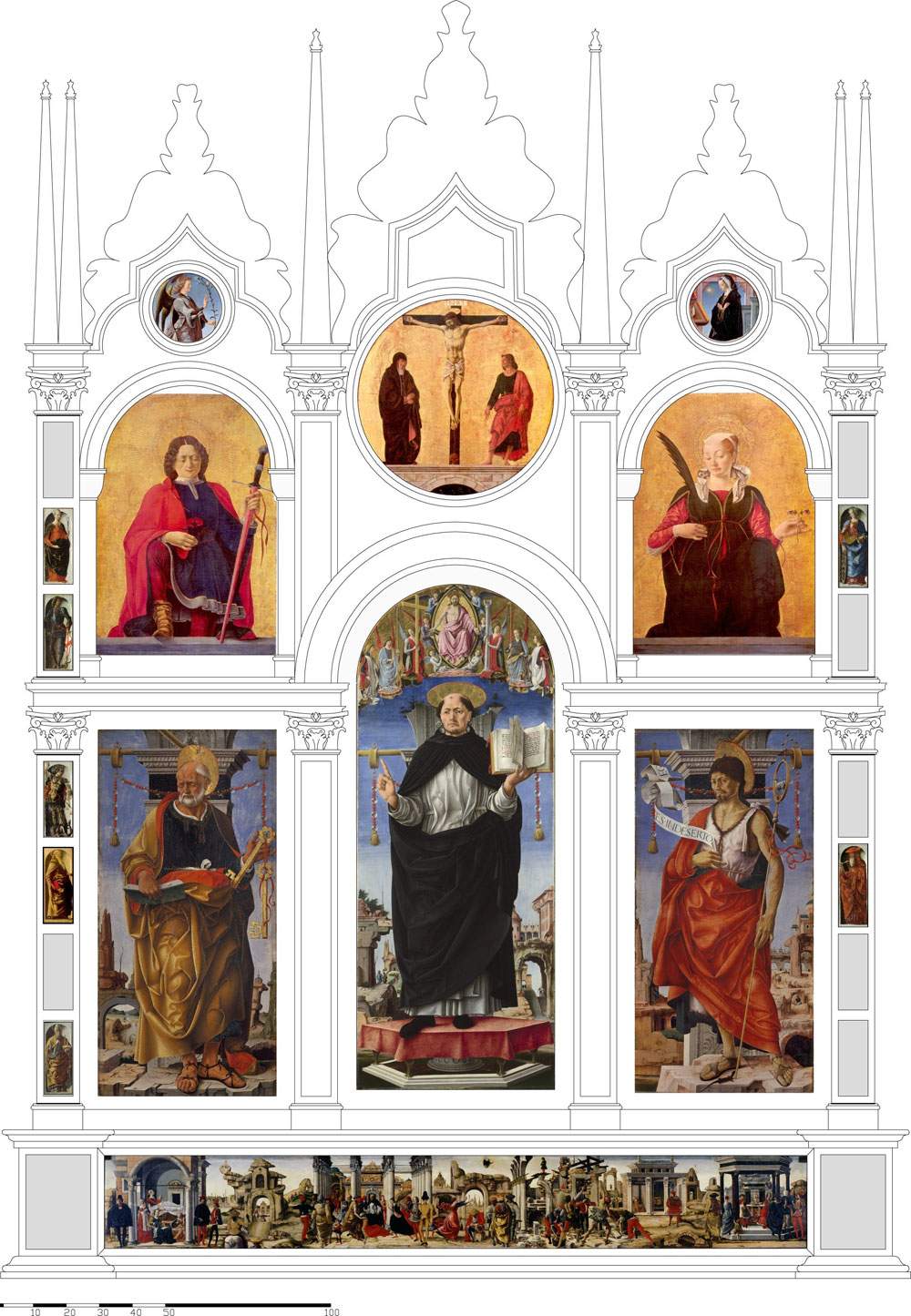More than five hundred years after its creation, the Griffoni Polyptych by Francesco del Cossa and Ercole de’ Roberti will be the protagonist of an exhibition in Bologna, at Palazzo Fava, after its reconstruction: in fact, for the first time, one of the greatest masterpieces of the Italian Renaissance will be seen reunited again in all its parts after three hundred years since its disintegration.
The extraordinary event, which will be held from March 12 to June 28, 2020, will be made possible thanks to loans from the museums that own the existing parts of the polyptych: the National Gallery in London, the Pinacoteca di Brera, the Louvre, the National Gallery of Art in Washington, the Cagnola Collection in Gazzada (Va), the Vatican Museums, the Pinacoteca Nazionale in Ferrara, the Museum Boijmans Van Beuningen in Rotterdam, and the Vittorio Cini Collection in Venice.
There will betwo main initiatives at the event: one focused on the altarpiece and its historical importance, which will be curated by Mauro Natale in collaboration with Cecilia Cavalca, and the other on the work of Factum Foundation and the importance of digital technologies in the protection and sharing of cultural heritage, which will be curated by Adam Lowe, Guendalina Damone and the Foundation team.
“This exhibition is an extraordinarily fascinating event, historically, artistically and culturally; a unique tribute to Bologna and the people of Bologna, who will be able to see ’back home’ a work that was born in San Petronio more than 500 years ago. But it is also a great opportunity for everyone to rediscover one of the greatest masterpieces of the Italian Renaissance. The joy of seeing the work reassembled again, repays us for a work that lasted more than two years. A bet won, with pride, together with the curators,” said Fabio Roversi-Monaco, President Genus Bononiae. Museums in the City.
The Griffoni Polyptych was made for the family chapel of Floriano Griffoni in the Basilica of San Petronio in Bologna between 1470 and 1472. It was during the execution of the altarpiece dedicated to Saint Vincent Ferrer that the collaborative relationship between Francesco del Cossa and the younger Ercole de’ Roberti began; the frame, on the other hand, was worked on by the shipwright Agostino de Marchi da Crema.
In about 1725 Monsignor Pompeo Aldrovandi, the new owner of the chapel, had the altarpiece dismantled, dividing it into individual parts to be used as room paintings for the family’s country residence in Mirabello, near Ferrara. That is why the polyptych was never reunited again: the paintings entered the antiquarian and collector’s market and then came to the new museums that still guard them today.
Roberto Longhi in his Officina Ferrarese, in 1934, imagined a reconstructive hypothesis, and in the 1980s a sketch of the polyptych attached to a correspondence by Pompeo Aldrovandi was found that provided proof of the almost complete accuracy of Longhi’s hypothesis. Cecilia Cavalca’s reconstruction visible in the exhibition is so far the most reliable and predicts the presence of at least seven figures of saints on the side pillars.
“The Polyptych was born at a crucial moment in Italian - and therefore world - art history in which Francesco del Cossa and Ercole de’ Roberti fully participated. To illustrate the result of their collaboration is to highlight the prominence of Bologna in the broader panorama of Renaissance art. With the Polyptych, a new canon of rendering of space and volume was invented. The road to modernity indicated by the two Ferrara artists in the Griffoni Polyptych can be considered an alternative to that of Piero della Francesca and Andrea Mantegna. It is somehow a ’figurative mosaic,’ which then corresponds to the fate of the dispersion of the various parts. It would be truly extraordinary if the exhibition would trigger a kind of race to find the missing elements,” added Mauro Natale, curator of the exhibition.
In addition to the display of individual works on the piano nobile of Palazzo Fava, visitors will be able to see the reconstruction of the Polyptych by Adam Lowe, founder of Factum Foundation, which for the past twenty years has been dedicated to recording, archiving, high-resolution digital restoration and the production of exact copies of works of art that combine technology and craftsmanship. Beginning in 2012, through a collaboration between the Basilica of San Petronio, Cavina Terra Architetti Studio and Factum Foundation, the sixteen panels of the Griffoni Polyptych have been documented in each of the museums that own the constituent parts.
“The aura of a work of art, that intangible thing that has been used to define its originality, is actually its material presence. Through high-resolution recording, digital mediation and new visualization and re-materialization technologies, we can have a deeper understanding of the material aspects that make any object what it is. This evidence reveals not only how an object was made, but also how it was curated, evaluated, transformed, and moved from one city to another or from one type of institution to another,” said Adam Lowe.
The exhibition The Rediscovery of a Masterpiece is initiated by Genus Bononiae. Museums in the City.
Pictured is the reconstructive hypothesis of the Griffoni Polyptych.
 |
| The Griffoni Polyptych, a masterpiece by Francesco del Cossa and Ercole de' Roberti, reunites in Bologna after 300 years |
Warning: the translation into English of the original Italian article was created using automatic tools. We undertake to review all articles, but we do not guarantee the total absence of inaccuracies in the translation due to the program. You can find the original by clicking on the ITA button. If you find any mistake,please contact us.